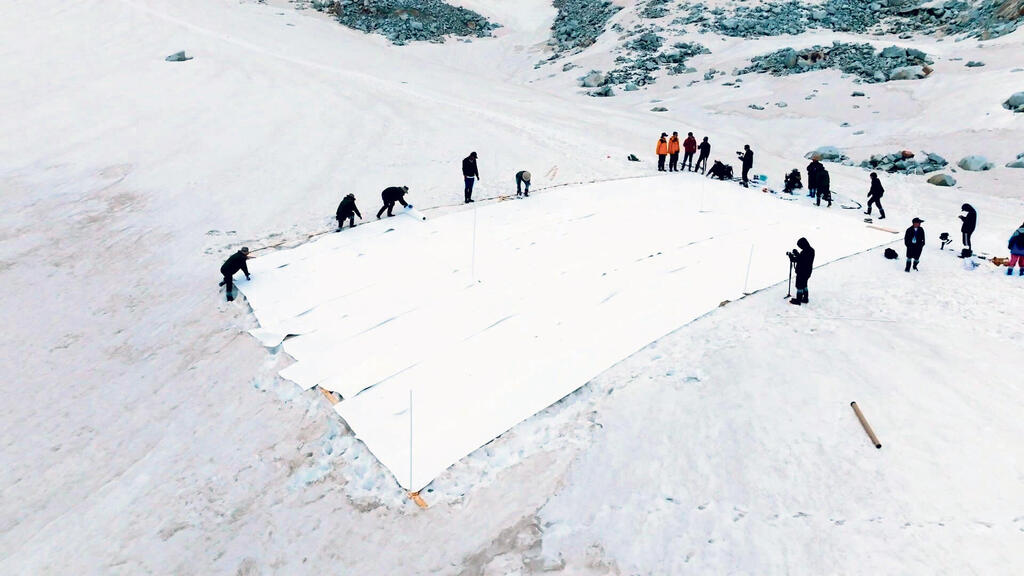
Could deploying a massive sunshade help curb Earth's rising temperatures?
From blankets that cover glaciers, to water cannons that create white clouds to reflect the sun's rays, scientists are investigating innovative solutions to a long-term problem
With the ongoing climate crisis and the speed with which it is hitting us, more and more researchers and entrepreneurs are looking for solutions outside of the box. Experts warn that these ideas are very dangerous, that the governments do not fully know how to deal with climate engineering, and that billionaires are looking at this as yet another frontier from which they can profit.
In a series of interviews, Calcalist spoke to various climate experts about innovative solutions to tackle the crisis.
The sun also rises
"We won't succeed in reducing greenhouse gas emissions to zero," says Professor Yoram Rosen, head of the Space Research Institute at the Faculty of Physics at the Technion. "Let's reduce what is heating the Earth - the rays of the sun."
Is it even possible?
"By deploying a massive sunshade about 1.5 million kilometers from the Earth. Satellites will hold it in the air and orbit it with the Earth at the same pace, providing it with shade. If we spread such a sunshade, we can reduce about 2% of the sunlight reaching us from the sun, and the average temperature on Earth will decrease by about 1.5 degrees Celsius within a year. We'll feel the impact immediately. In fact, those who will primarily experience the effect are those living under the designated shade, in regions close to the equator. But if the temperature there indeed drops, the global average will also decrease with it."
For Rosen, this is no science fiction - he leads research precisely in how to shade the Earth. The large sunshade that Rosen and his colleagues at the Technion (with partners from the United Arab Emirates) are developing is supposed to be made of kapton, a material that reflects light and is 10 micrometers thick. It is used, among other things, in space blankets (which every pilot has) and satellites. They will be able to deploy it according to the need, thus changing the scope of the shading. According to their calculations, for such a sunshade to be effective, it should be a square shape, with a length and width of 1,600 kilometers, which is about 2.5 million cubic kilometers, larger than Saudi Arabia or Algeria but smaller than Kazakhstan or Argentina. Rosen and his colleagues believe it can be divided into smaller sections.
They are starting with an initial "technological sample" to "demonstrate that we have all the necessary technology," says Rosen. "It will be a very small prototype, about the size of a classroom white board. Currently, we are determining the right materials and how best to deploy it, but if we manage to stabilize it, and it indeed produces shade, I hope that countries around the world will adopt the solution and join in its joint implementation."
Is this realistic in our lifetime?
"It can be done in stages, deploying fabric the size of the Kinneret on a satellite every day until it covers everything. When it's completed within a year, we will already see temperatures drop. This will be the largest project man has ever been involved in. However, it's important to note that its purpose isn’t to enable humanity to continue emitting greenhouse gasses. Our sunshade can only reduce the damage, not address the root of the problem. Emissions need to be reduced regardless."
How much would such a solution cost?
"Our technological sample requires about $10 million, and for the entire world it could reach $30 trillion - the national debt of the United States. In about five years, we'll be able to place the technological sample at the designated point, and when we are convinced that it works, we can say, 'Hey, folks, there's a solution. Let's implement it.'"
Climate engineering
This is an extreme solution, but it's not the only one. In recent years, new and innovative solutions to cool the Earth have emerged. Professor Rosen’s solution isn’t even the only one seeking to shade the Earth: a group of researchers at MIT are currently exploring the possibility of creating a synthetic surface of densely packed bubbles, made of silicone or other materials, which will also be deployed about 1.5 million kilometers from the ground (the distance where the gravitational forces of the Earth and the sun are balanced) and will reduce some of the solar radiation reaching us. This one will be much larger than the sunshade: about 8 million cubic kilometers (approximately the size of Australia or Brazil).
But it's not just about shade. Recently, as the crisis deepens, more and more scientists and entrepreneurs are trying to find solutions to lower temperatures through solar radiation modification (SRM), at least until we properly reduce greenhouse gas emissions. Some of the proposed solutions are fascinating but raise tough ethical questions or health concerns. But the debate is gaining momentum, taking place not on the fringes among eccentric inventors but in the centers of power. After decades during which politicians have done next to nothing to combat the climate crisis and are still struggling to implement the necessary solutions, they are now starting to contemplate science-fiction-like ideas, hoping to delay the inevitable. Combined with billions invested by some billionaires, we are likely to see more such inventions, which may be even riskier than ice shades.
In February, about 300 renowned researchers from leading institutions worldwide, including NASA, Columbia, Harvard, and others, published an open letter calling for support for SRM research, explaining that artificial climate engineering is "almost unavoidable" in the current situation. The scientists, including former NASA scientist James Hansen, emphasized that climate engineering is not the way to tackle climate change, but research and experiments are needed to understand if it can be efficiently used when it becomes clear that reducing greenhouse gas emissions is not enough.
At the end of June, the White House released a report on climate engineering (also known as solar geoengineering) at the request of Congress, recommending to examine the field and consider launching a five-year research program to study different methods of "managing" solar radiation, on Earth and beyond. The emphasis is on "risk versus reward," but the fact that it addresses the topic again underscores the ongoing American failure to do what really needs to be done - reduce emissions.
Break the ice
The Dagu Glacier in Sichuan Province in southwestern China, about 5,000 meters above sea level, is a central source of life in the region. It provides drinking water, aids in electricity production, and attracts tens of thousands of tourists each year, contributing to the locals' livelihood. However, it is melting. Therefore, in early July, scientists from Nanjing University climbed the glacier equipped with oxygen balloons and blankets. They began spreading these giant blankets made of special, water-repellent, natural fiber fabric that restrict heat transfer, and because they are also reflective, they return 93% of the light falling on the glacier. At the end of the operation, about 400 cubic kilometers of the glacier were covered with the blankets, designed to protect it from the sun, prevent its melting or at least slow down the process.
This is an urgent matter. In the past half-century, about 70% of Dagu Glacier has melted, and about 15% of glaciers in China have disappeared entirely. Half of the world's approximately 200,000 glaciers could disappear entirely by the end of the century. This will affect all the ecosystems that humanity relies upon, depriving people of fresh water and food.
For now, there are blankets. This relatively simple method is already being used in ski resorts in Austria, France, Germany, Italy, and Switzerland, and it works. Research indicates a 50-70% slowdown in the melting rate of glaciers. However, there is a difference between a localized solution for a ski resort and a widespread solution to protect giant glaciers. The latter is a costly affair: covering the largest glacier in Switzerland, for example, would cost about $1.5 billion, and covering all glaciers worldwide would cost over a trillion dollars in just one year. There are additional risks involved. Blankets containing plastic could harm natural ecosystems even more than the melting of the glacier. In any case, it is only a temporary solution.
Show me the money!
In general, the more innovative and almost visionary an initiative is, the more expensive it becomes. Fortunately, the world's prominent billionaires have already discovered climate engineering and are enthusiastic about it. Bill Gates, Jeff Bezos, and George Soros, for example, have so far made significant donations to SRM research. Soros even spoke passionately about the topic in February, on the international stage of the Munich Security Conference, stating that the melting of glaciers in Greenland is a "threat to civilization's survival" and that funding is needed to address the problem. His focus is what's called cloud brightening - creating bright clouds that reflect some of the radiation.
Gates contributed to a project by Harvard scientists that investigated injecting sulfate aerosols (fine particles of sulfur dioxide) into the atmosphere to block some of the sunlight. The project, planned for Swedish airspace, was eventually canceled due to protests by local residents and environmentalists. Bezos utilized Amazon's powerful computing capabilities to simulate the possible effects of injecting massive amounts of sulfate aerosols into the atmosphere, for the same purpose of cooling the planet. Even Dustin Moskovitz, one of the co-founders of Facebook, donated around $900,000 to climate engineering research.
It is understandable why billionaires are drawn to this field - it is innovative, nearing fantastical, has a global impact, and appears to be easy to solve. Much easier than admitting that the economic system that made them billionaires is contributing to the climate crisis, and much easier than trying to lead a massive global effort to cut greenhouse gas emissions. It's much cooler to talk about clouds.
The cloud's silver lining
Bright clouds can naturally reflect more sunlight and thus cool areas below them. This idea has been studied since the 1990s, but now it is also being tested over Australia's Great Barrier Reef, as the rising sea temperature there is leading to coral bleaching.
So how does cloud brightening actually work? A cannon-like fan shoots seawater particles at a low altitude. The air carrying the particles rises to the clouds, and the more particles there are, the denser the clouds become and the more sunlight they block (and the denser the clouds, the whiter they appear, hence "cloud brightening").
One of the participants in the Australian experiment is Professor Daniel Rosenfeld, a climate scientist from the Hebrew University. According to him, many attempts to block sunlight are based on aerosol manipulations - floating particles, natural or man-made, like dust or smoke, that can block sunlight. They are tiny, of course, but when they accumulate in a cloud, for example, their effect can be quite significant.
"If we pollute the air with smoke from a ship's exhaust, then there are more aerosols that can serve as nuclei for cloud formation - and thus clouds are created," Rosenfeld said. "The brighter the clouds are, the more heat they reflect back into space, and the less the Earth warms."
In other words, there are things such as wildfires, that on one hand pollute the air, but also block the sun.
"Yes, today's air pollution reduces about a quarter of global warming. What we’re saying now is, let's do it in a targeted way, and with non-pollutive means - seawater. The idea is to spray large quantities of seawater, in very fine droplets, to create the same effect as aerosols. This is the first experiment in the world of its kind."
And what has this experiment, which you have already conducted over two summers, revealed so far?
"Our seawater spray reached the clouds, and we saw that the smaller the droplets, the more water they attract and accumulate. We measured it directly within the clouds using research aircraft and also with satellites. In other words, droplets increase the surface area of the clouds, and then the clouds reflect more radiation and cool the surface below." Based on these findings, the researchers will conduct another experiment during the next Australian summer in February.
Sea spray to the rescue
Seawater spray is the most benign aerosol option, but there are much darker possibilities - sulfur dioxide, for example. In 1991, Mount Pinatubo in the Philippines erupted, dispersing thousands of tons of such sulfur aerosols into the air, and the global temperature decreased by an average of 0.5 degrees Celsius for two years. In 1815, the eruption of Mount Tambora in Indonesia caused the "year without a summer" due to an aerosol cloud the size of Australia which blocked the sun's rays and altered the climate, which caused temperatures to lower dramatically. Lakes and rivers froze in July and August, heavy rains occurred, and crop failures happened worldwide. So, on the one hand, sulfur dioxide aerosols may seem like an effective cooling solution, but on the other hand, no one knows where it might lead, and the potential harm to the world could be enormous.
Last year, researchers from Yale University even calculated that the injection of such particles into the air could hypothetically refreeze the Arctic. They also outlined a hypothetical plan to achieve this: 125 planes would need to fly about 175,000 flights at high altitudes each year, releasing sulfur aerosols around northern Alaska and the southern tip of Patagonia. This is expected to cool the Earth by no less than 2 degrees Celsius. Moreover, these planes would also release millions of tons of harmful greenhouse gasses, and may fill the air with other chemicals, raising concerns about respiratory problems, acid rain, and damage to the ozone layer. Science fiction has a very dystopian side too.
Nevertheless, the matter is being explored, even in Israel. Stardust Labs, based in Ra'anana, is trying to develop a substance that could achieve the same cooling effect produced by volcanic eruptions' particles, but without the pollution. Among its founders are Professor Eli Waxman, head of the Particle Physics and Astrophysics department at the Weizmann Institute and former Chief Scientist of the Israeli Atomic Energy Commission (IAEC), and Dr. Yanai Yedvab, former Deputy Chief Scientist at the IAEC. According to the company, their solution is "the only one that can lower global temperatures within a few years" and one gram of the planned particles can offset the warming effect of one ton of greenhouse gasses. They also have said that their solution is "a thousand times more cost-effective than any alternative."
A high-risk investment
The question, of course, is how dangerous all of this might be. Past human interference in the climate is what led to the current situation, and it is difficult to predict the extent of damage that further intervention may cause.
What will happen, for example, if sulfur dioxide aerosols are injected into the air? No one really knows, and, even if it succeeds in the short term, what comes next? Will we become dependent on yet another expensive technology? According to the latest UN Environment Programme report, released in February, such a solution is unsustainable, though it does not entirely dismiss research in the field.
The White House report explicitly mentions that some of the technology in the field could cause irreversible harm to humans and the environment but recommends examining what is more dangerous - these technologies or continued global temperature rise. The European Union in June called for international talks on the threats of climate engineering, which embody a "level of risk unacceptable to humanity and the environment."
"No one should conduct experiments with the sun without discussing it in the proper forum, at the highest international level," said Frans Timmermans, the EU’s climate chief.
Also among scientists, there are many who warn of the possible consequences, including costs, expected longevity and timelines. There are a plethora of concerns, from damaging the ecosystem to an increase in extreme weather events worldwide and damage to the ozone layer. As early as January 2022, over 400 researchers from universities and major research institutions, including those working for the UN, argued that the risks may only be fully understood once the technologies are deployed on a massive scale or even years after the fact, and called for a global agreement to ban the use of such technologies.
Additionally, proposals to produce clouds or sunshades may create the impression that some kind of magical solution exists, which could undermine real efforts to save the Earth by reducing emissions.
Professor Alon Tal, a climate expert, chair of Tel Aviv University’s Department of Public Policy, and a former member of the Knesset for the Blue and White party, is about to publish a book on public policy and climate innovation. He believes that the entire field of climate engineering is "a really bad idea.”
"Implementing these ideas on a large scale could lead to damage to the ozone layer, changes in precipitation patterns, and more,” says Tal. “There are a lot of uncertainties. It's also a question of sustainability. If we knew that these solutions would continue forever, that would be one thing, but once these systems stop working, global warming will return twice as strong. I don't know a serious person who really thinks this could be a long-term solution. It's not genuine emission reduction."
Professor Rosenfeld, the scientist who is spraying seawater particles at a low altitude over the Great Barrier Reef, is a world-renowned climate scientist who serves on the UN's Intergovernmental Panel on Climate Change (IPCC). He agrees with Professor Tal and emphasizes the importance of global coordination to address all these issues: "The way forward is through global agreement. No country can unilaterally decide to implement such solutions on its own."
What is the risk of resorting to such solutions?
"When we open the door for them, leaders who have already been convinced to challenge the power of the fossil fuel companies and reduce emissions will seize upon these new solutions, which do not yet exist. It will only give the oil companies more time to nurture our dependence on their products. It's dangerous. The decarbonized vision we are pursuing, through getting rid of polluting fuels, is a much better reality than any alternative. Anything else is akin to taking painkillers without addressing the root of the problem."
Could your experiment have such consequences?
"A conference held in Washington in 2010 established uniform standards for climate engineering, concluding that no action with climate impact would be taken without global agreement. In the case of the coral-shade, it is limited only to the coral, and all we are doing is correcting anomalies with natural materials, so I don't see any negative consequences here. If we cool locally, the effects are short-term and non-dispersive, and the 'disruption' we create is not significant."
Nevertheless, are there no advantages to any of these new solutions?
"In parallel to the imperative to reduce emissions, there is growing recognition that we need to develop technology that will be at our disposal if we reach a climate emergency. Even if we believe that we will succeed in turning the tide and reducing emissions, we must also preserve ecological systems until we return temperatures to sustainable values because even now, warming is crossing a threshold that is changing the world before our eyes. Humans engineered agriculture, so now we will engineer the climate, as long as we are cautious and adhere to ethical principles. Sometimes, you need to take a painkiller to reduce the temperature until you treat the root of the problem."

















